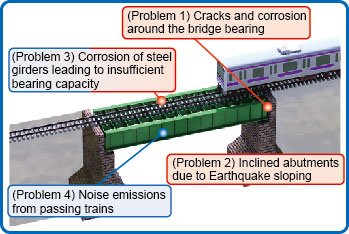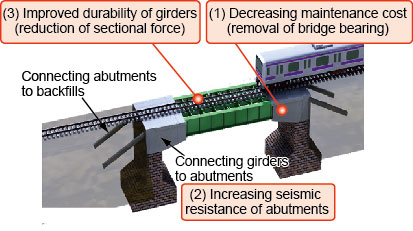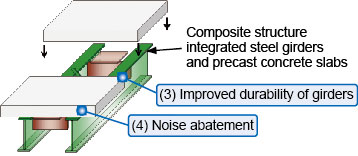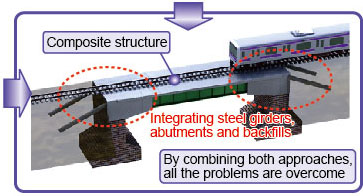4.A technique to restore deteriorated steel bridges
- A technique has been developed for restoring old bridges consisting of two work methods integrating abutments, steel girders and the backfills, composing steel girders and precast concrete floor slabs.
- This technique cuts the cost of repair work by 50% compared to steel girder replacement.
There are many old steel railway bridges suffering age damage and needing bridge replacement than road bridges. As steel bridges grow old, cracks appear on bridge bearings of abutments, reducing their bearing capacity, and the steel girders underneath sleepers begin to corrode, inter alia. Abutments may also suffer damage and incline due to seismic action. In addition, the noise generated from steel girders under sleepers is also deep problems (Fig.1). Consequently, there is a growing need not only for measures to strengthen steel bridges but also to replace them.
An integrated “steel girder – abutment – backfill” technique was therefore developed to maintain the old steel girders and restore the bridge by connecting the abutment to steel girders by the reinforced concrete leaving the old bridge bearings, and coupling the abutments to the backfills with nail-reinforced soils. This approach not only extends the life of old steel bridges, but also increases their resistance to earthquakes (Fig.2).
Another technique, the “composite structure method” integrates old steel girders to precast concrete slabs which are used as the measure for reinforcing the steel girders and abating noise (Fig.3). Trial works were performed on a full-scale test bridge on which loading tests were performed to verify the effectiveness of both techniques. The two techniques can also halve the cost of conventional steel girder replacement work. Combination of the two approaches not only extends the life of these age-damaged bridges, they also increase resistance to seismic action and can help to reduce noise emissions (Fig.4).

Fig.1 Problems surrounding steel bridges with abutments
Fig.2 Technique to integrate steel girders, abutments
and backfills (resolves problems 1, 2 and 3)

Fig.3 Technique to integrate steel girders and precast
concrete slabs (resolves problems 3 and 4)
Fig.4 Combination of both techniques